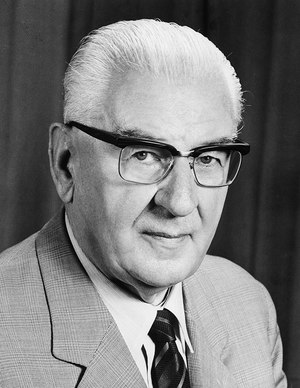
Unternavigation
Arnold Saxer
Arnold Saxer (1896-1975) served as director of the Federal Social Insurance Office for many years and was involved in a series of fundamental expansions and reforms to the Swiss welfare state.
Saxer completed his studies at the University of St. Gallen (HSG) as a qualified teacher of commercial studies, before going on to study law and political science at the universities of Bern and Zurich, where he obtained his doctorate in 1920. In the 1920s and 1930s, he worked for the liberal National Association of Independent Swiss Workers (LFSA) and the Central Association of Swiss Embroiderers. In addition, he pursued a political career as a member of the Free Democratic Party, initially in city council of St. Gallen as well as in the cantonal parliament from 1924 and as a national councillor from 1933.
Saxer was affiliated with the moderate, socially progressive wing of the FDP. For instance, in his role as national councillor, he drafted a motion for the introduction of the AHV. In 1938, the Federal Council appointed him as director of the Federal Social Insurance Office (BSV). The Federal Council initially commissioned him with preparing a feasibility study for the planned old age insurance. Work on the project was interrupted by the outbreak of the Second World War. Priorities then quickly changed in the BSV. In the winter of 1939/1940, Saxer began working on the development of wartime welfare and the swift introduction of Income Substitution Insurance for Militia Soldiers (EO). Furthermore, Saxer was responsible for preparing the constitutional article on family protection. After the Federal Council had declared the establishment of the AHV as its priority in 1944, this concern became the focus of Saxer’s work. Alongside federal councillor Walther Stampfli and two other BSV civil servants, mathematician Ernst Kaiser and lawyer Peter Binswanger, Saxer joined a committed group of experts who played a crucial role in drafting the AHV bill. He opposed the Beveridge Plan as well as plans for a strong public old age provision that would have absorbed existing occupational pension plans. Instead, he and Stampfli preferred a two-tier system comprising a modest AHV that would merely guarantee basic benefits and would be supplemented by independent pension funds. After the successful plebiscite of 1947, Saxer dedicated himself to expanding the AHV in the 1950s and to designing and establishing disability insurance in 1960. Once Saxer retired, he wrote a partly historical, partly legal account of the development of the Swiss welfare state. His work (‘Social Security in Switzerland’, in German: ‘Die soziale Sicherheit in der Schweiz’) was published for the first time in 1963; it was reissued a number of times thereafter and translated into French and English.
Literatur / Bibliographie / Bibliografia / References: Leimgruber, Matthieu (2008). Solidarity Without the State? Business and the Shaping of the Swiss Welfare State, 1890-2000, Cambridge.
(12/2014)




